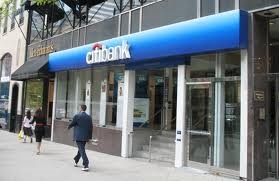The share price of mega-bank Citigroup (NASDAQ:C) continued to slip today as the once mighty firm continues to embrace the roll of the “Sad Sack” of the world banking sector. Last Wednesday, 02 April, Citi shares closed at 48.25. The share price has closed lower each succeeding day, at 47.66 on Thursday, 47.11 on Friday, and 46.55 yesterday. Right now it is trying to recover from a drop to 46.13, but that seems doubtful.

Has the Possible Become Impossible?
The bank warned yesterday afternoon that it may not be able to meet a key profitability target, the ratio of profit to shareholder equity.
The warning followed last month’s rejection of Citi’s capital plan by the US Federal Reserve Bank. Citi had crafted a plan announced in 2012 that was intended to mend relationships with regulators and ramp up profitability for investors.
One institutional investor in Citi said that “When you decide to change the CEO of a company (which Citi did in 2012), and one of the goals is to improve the relationship with regulators and it doesn’t happen, that’s disappointing.”
Citi CFO, John Gerspach, hinted on March 3rd that the bank might be facing some continuing problems, saying that it would “clearly have to increase the amount of capital it returned to shareholders, subject to regulatory approval,” if it expected to reach its goal. Without regulatory approval, reaching the goal is now seriously in doubt.
Will Regulation Cause the “Too Big to Fail” to Fail?
Yet another stone in Citi’s shoe is that it has agreed to pay $1.13 billion in investor claims resulting from the 2008 banking crisis. While other banks are on the road to recovery, Citi continues to be constantly sailing between Scylla and Charybdis with no hope of passing into quieter waters.
On the one side of the good ship Citi is the continuing pressure of regulators who, by their rules, are stunting the growth potential of the bank while trying to control its stability. On the other side of the ship are investors who are looking for more generous returns that are not likely to be soon forthcoming because of the force of regulation. The question is how long can Citi sail between these two necessary evils and expect to survive?
Don’t get me wrong. I’m not against regulation. If anything ever needed to be regulated, it is surely the banking industry. What I am saying is that the tipping point of the 2008 financial crisis was governments stepping in to bail out institutions that were considered “too big to fail.” What if Citi is unable to survive the twin pressures on its hull? What if someone decides that Citi is too big to fail? What happens then?
As another writer pointed out, “Regulation does not live in a vacuum. It is a prisoner to conflicting socio-economic and political pressures. Banks are under pressure to [both] hold more capital whilst also being asked to lend more. These are dissenting priorities that cannot co-exist.” The report added that complex regulatory requirements actually “refocus the efforts of financial institutions not on managing their risks prudently but rather on arbitraging regulation — the same mistake that led to the last crisis.”
It’s a scary situation. On a positive note, the Citi share price has ticked upward and is at 46.81 approaching the noon hour on the US east coast.

 Hot Features
Hot Features











